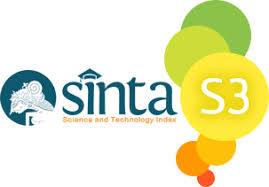Penerapan online social convergence dalam pemberitaan bencana: analisis konten kualitatif pada situs web disasterchannel.co
 Abstract views: 665
,
Abstract views: 665
,
 PDF downloads: 595
PDF downloads: 595
Abstract
When a natural or human-caused disaster occurs in the rapid digital development era, the phenomenon of massive dissemination of information from citizen journalism emerges. This research uses the qualitative approach to describe online social convergence in disasterchannel.co, a disaster portal website where most of the articles come from citizen journalism. A total of 15 articles were reviewed with content analysis to understand the application of online social convergence in disaster reporting, which consists of seven aspects: helping; being anxious; returning; supporting; mourning; exploiting, and being curious. In general, seven aspects of online social convergence have been applied in the article published by disasterchannel.co. The most often aspect that appears are supporting and helping. This study shows that disasterchannel.co has implemented online social convergence through citizen journalism articles published on their website.
References
Arif, A. (2010). Jurnalisme Bencana, Bencana Jurnalisme: Kesaksian dari Tanah Bencana. KPG.
Barret, A. K., & Posey, C. (2019). Organizational crisis communication in the age of social media. In K. Stephens (Ed.), New Media in Time of Crisis (pp. 15–41). Routledge.
Cooper, G. (2014). Boxing Day tsunami heralded new era of citizen journalism. The Conversation. https://theconversation.com/boxing-day-tsunami-heralded-new-era-of-citizen-journalism-35730
Disasterchannel.co. (2015). Tentang Kami. https://disasterchannel.co/tentang-kami/
Eriyanto. (2011). Analisis isi: Pengantar metodologi untuk penelitian ilmu komunikasi dan ilmu-ilmu sosial lainnya. Kencana Prenada Media Group.
Farinosi, M., & Treré, E. (2014). Challenging mainstream media, documenting real life and sharing with the community: An analysis of the motivations for producing citizen journalism in a post-disaster city: Global Media and Communication, 10(1), 73–92. https://doi.org/10.1177/1742766513513192
Hughes, A. L, Paley, L., Sutton, J., Liu, S., & Vieweg, S. (2008). Site-seeing in disaster: An examination of online social convergence. Proceedings of the 5th International ISCRAM Conference. https://www.researchgate.net/publication/228799549_Site-seeing_in_disaster_An_examination_of_on-line_social_convergence
Hughes, A. L. (2019). Site-seeing in disaster: Revisiting online social convergence a decade later. In K. Stephens (Ed.), New Media in Times of Crisis (pp. 193–208). Routledge.
Jurrat, N. (2011). Mapping Digital Media: Citizen Journalism and the Internet - Open Society Foundations. Open Society Foundation - Reference Series. https://www.opensocietyfoundations.org/publications/mapping-digital-media-citizen-journalism-and-internet
Kendra, J. M., & Wachtendorf, T. (2003). Reconsidering convergence and converger: Legitimacy in response to the World Trade Center disaster. Research in Social Problems and Public Policy, 11, 97–122. https://doi.org/10.1016/S0196-1152(03)11007-1/FULL/XML
Monggilo, Z. M. Z. (2020). Analisis konten kualitatif hoaks dan literasi digital dalam @Komikfunday. Interaksi: Jurnal Ilmu Komunikasi, 9(1), 1–18. https://doi.org/10.14710/interaksi.9.1.1-18
Nakamura, F. (2012). Memory in the debris: the 3/11 Great East Japan earthquake and tsunami. Anthropology Today, 28(3), 20–23. https://doi.org/10.1111/j.1467-8322.2012.00874.x
Palen, L., & Liu, S. B. (2007). Citizen communications in crisis: Anticipating a future of ICT-supported public participation. Conference on Human Factors in Computing Systems - Proceedings, 727–736. https://doi.org/10.1145/1240624.1240736
Paris, C. M., & Rubin, S. (2013). Backpacking, social media, and crises: A discussion of online social convergence. Information and Communication Technologies in Tourism 2013, 207–217. https://doi.org/10.1007/978-3-642-36309-2_18
Pavlik, J. V. (2019). Journalism in The Age of Virtual Reality : How Experiential Media Are Transforming News. Columbia University Press.
Robinson, S. (2009). “If you had been with us”: Mainstream press and citizen journalists jockey for authority over the collective memory of Hurricane Katrina. New Media and Society, 11(5), 795–814. https://doi.org/10.1177/1461444809105353
Stephens, K. (2019). Focusing on crisis responder. In K. Stephens (Ed.), New Media in Time of Crisis (pp. 11–13). Routledge.
Wahyuni, H. I. (2013). Kebijakan Media Baru di Indonesia: Harapan, Dinamika, dan Capaian Kebijakan Media Baru di Indonesia. Gadjah Mada University Press.
Yudiawan, D. (2021). Bagaimana seharusnya jurnalis memberitakan bencana? In Memahami Bencana Alam di Indonesia: Peran Media dan Cara Melawan Hoaks Bencana (pp. 44–49). Aliansi Jurnalis Independen & Google News Initiative.
Copyright (c) 2022 Jurnal Komunikasi Profesional

This work is licensed under a Creative Commons Attribution-ShareAlike 4.0 International License.

Jurnal Komunikasi Profesional is licensed under a Creative Commons Attribution-ShareAlike 4.0 International License.
1. Proposed Policy for Journals That Offer Open Access
Authors who publish with this journal agree to the following terms:
- Authors retain copyright and grant the journal right of first publication with the work simultaneously licensed under a Creative Commons Attribution License that allows others to share the work with an acknowledgment of the work's authorship and initial publication in this journal.
- Authors are able to enter into separate, additional contractual arrangements for the non-exclusive distribution of the journal's published version of the work (e.g., post it to an institutional repository or publish it in a book), with an acknowledgement of its initial publication in this journal.
- Authors are permitted and encouraged to post their work online (e.g., in institutional repositories or on their website) prior to and during the submission process, as it can lead to productive exchanges, as well as earlier and greater citation of published work (See The Effect of Open Access).
2. Proposed Policy for Journals That Offer Delayed Open Access
Authors who publish with this journal agree to the following terms:
- Authors retain copyright and grant the journal right of first publication, with the work [SPECIFY PERIOD OF TIME] after publication simultaneously licensed under a Creative Commons Attribution License that allows others to share the work with an acknowledgement of the work's authorship and initial publication in this journal.
- Authors are able to enter into separate, additional contractual arrangements for the non-exclusive distribution of the journal's published version of the work (e.g., post it to an institutional repository or publish it in a book), with an acknowledgement of its initial publication in this journal.
- Authors are permitted and encouraged to post their work online (e.g., in institutional repositories or on their website) prior to and during the submission process, as it can lead to productive exchanges, as well as earlier and greater citation of published work (See The Effect of Open Access).



